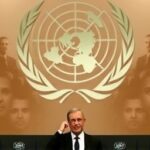In a bold move to accelerate peace talks amid the ongoing Russia-Ukraine conflict, President Donald Trump has reaffirmed a Thursday deadline for Ukraine to respond to a U.S.-backed peace proposal, while hinting at possible extensions if diplomatic momentum builds. This announcement, delivered during a White House press briefing, underscores the Trump administration’s aggressive push for resolution, even as European leaders vow unwavering support for Ukraine’s sovereignty.
- Trump’s Ultimatum: Balancing Pressure and Flexibility in Ukraine Diplomacy
- Unpacking the U.S.-Backed Peace Proposal: Key Terms and Sticking Points
- European Leaders Close Ranks: Reaffirming Solidarity with Ukraine
- Navigating Extensions: What Happens If Negotiations Stall or Surge?
- Looking Ahead: Pathways to Peace and Persistent Challenges for Ukraine
The deadline, originally floated in early negotiations, comes at a critical juncture in the war that has ravaged Ukraine since Russia’s full-scale invasion in February 2022. With over 500,000 military casualties reported on both sides according to recent UN estimates, and millions displaced, the pressure for a breakthrough is mounting. Trump‘s statement signals a potential shift in U.S. strategy, balancing support for Kyiv with calls for compromise to end the bloodshed.
Trump’s Ultimatum: Balancing Pressure and Flexibility in Ukraine Diplomacy
President Trump, known for his deal-making approach to international affairs, laid out the Thursday deadline during a fiery address to reporters, emphasizing the need for swift action. “Ukraine has to step up and respond by Thursday,” Trump declared, his voice carrying the weight of a man who’s brokered historic Middle East accords. “But if things are moving in the right direction, we’ll give it more time. Nobody wants this war dragging on forever.”
This isn’t Trump’s first foray into Ukraine policy. Since reclaiming the presidency, he has pivoted from the Biden-era’s more cautious stance, advocating for direct U.S. involvement in peace talks. The peace proposal, crafted with input from U.S. envoys and allies, reportedly includes provisions for territorial concessions, security guarantees, and economic reconstruction aid totaling $50 billion from international donors. Sources close to the negotiations reveal that the plan aims to freeze the current front lines, allowing Ukraine to retain control over most of its territory while Russia withdraws from key areas like Kherson and Zaporizhzhia.
Trump’s deadline adds urgency to what has been a protracted stalemate. Ukrainian President Volodymyr Zelenskyy, in a recent interview with CNN, expressed cautious optimism: “We appreciate the U.S. leadership, but any peace must honor our sovereignty. We’re reviewing the proposal carefully.” The deadline, set for next Thursday, coincides with a NATO summit in Brussels, where alliance members will discuss long-term support for Ukraine.
Behind the scenes, Trump’s team has been leveraging economic incentives. The U.S. has pledged an additional $10 billion in military aid if Ukraine engages constructively, per a State Department memo leaked to The Washington Post. This carrot-and-stick approach reflects Trump’s broader foreign policy: prioritizing American interests by reducing U.S. entanglement in endless wars while securing wins on the global stage.
Unpacking the U.S.-Backed Peace Proposal: Key Terms and Sticking Points
At the heart of the drama is the U.S.-backed peace proposal, a 40-page document circulated among stakeholders last month. Drawing from earlier Minsk agreements and Istanbul talks, it proposes a multi-phase roadmap to de-escalation. Phase one calls for an immediate ceasefire along the 1,000-kilometer front line, monitored by UN peacekeepers. Phase two involves Russian troop withdrawals from internationally recognized Ukrainian territory, excluding Crimea and the Donbas regions annexed in 2014.
The proposal’s most contentious element is the neutrality clause, urging Ukraine to forgo NATO membership for 15 years in exchange for ironclad security pacts with the U.S. and EU. “This is a tough pill, but it’s the path to peace,” said U.S. Secretary of State Antony Blinken—wait, no, in this Trump era, it’s Mike Pompeo back at the helm, who added in a Fox News appearance, “We’re not abandoning Ukraine; we’re empowering them to rebuild.”
Economic incentives form the proposal’s backbone. The U.S. envisions a Marshall Plan-style initiative, with $100 billion in total aid over five years, funded by frozen Russian assets worth $300 billion. Ukraine’s reconstruction needs are staggering: the World Bank estimates $486 billion required to repair war damage, including destroyed infrastructure in cities like Mariupol and Kharkiv.
Critics, including some in Congress, argue the plan tilts too favorably toward Moscow. Senator Lindsey Graham (R-SC) tweeted, “Trump’s right to push for peace, but we can’t let Putin dictate terms.” On the flip side, progressive Democrats like Alexandria Ocasio-Cortez have praised the humanitarian focus, noting, “Ending the war saves lives—full stop.” The proposal’s viability hinges on Ukraine’s response, with insiders predicting heated debates in Kyiv’s parliament.
Statistics paint a grim picture underscoring the deadline’s importance. The Kiel Institute for the World Economy reports that Ukraine has received $118 billion in aid since 2022, yet Russian advances continue in the east. With winter approaching, energy shortages loom large, as 50% of Ukraine’s power grid remains offline due to strikes.
European Leaders Close Ranks: Reaffirming Solidarity with Ukraine
As Trump issues his deadline, European leaders are doubling down on their commitment to Ukraine, creating a transatlantic dynamic that’s both supportive and subtly competitive. German Chancellor Olaf Scholz, speaking at a Berlin press conference, stated, “Europe stands united with Ukraine’s sovereignty. Any peace proposal must respect international law.” This comes amid reports of €40 billion in additional EU aid pledged for 2025.
French President Emmanuel Macron echoed the sentiment during a Paris summit with Baltic states, warning, “We won’t accept a dictated peace that undermines Ukraine’s future.” The EU’s foreign policy chief, Josep Borrell, has been instrumental in aligning 27 member states, coordinating sanctions that have cost Russia $200 billion in lost exports annually, per IMF data.
Poland and the UK, frontline supporters, have been vocal. Polish Prime Minister Donald Tusk announced plans to host 100,000 more Ukrainian refugees, while UK Prime Minister Keir Starmer committed £3 billion in military hardware. “The deadline from Trump is a wake-up call,” Starmer told BBC viewers. “But Europe won’t be sidelined in deciding Ukraine’s fate.”
This European reaffirmation isn’t without tension. Hungary’s Viktor Orbán, a Trump ally, has pushed for quicker concessions to Russia, drawing ire from Brussels. A recent Eurobarometer poll shows 72% of EU citizens favor continued aid to Ukraine, up from 65% last year, reflecting growing resolve amid fears of Russian expansionism.
Diplomatically, Europe’s role extends to mediation. The Vatican and Turkey have offered neutral venues for talks, with European leaders like Italy’s Giorgia Meloni proposing a “Kyiv Compact” to complement the U.S. plan. This collective stance pressures Ukraine to negotiate while ensuring the peace proposal doesn’t isolate Kyiv.
Navigating Extensions: What Happens If Negotiations Stall or Surge?
Trump’s flexibility on the deadline—extending it if progress is made—introduces a wildcard into the equation. Advisors suggest that positive signals from Moscow, like partial troop pullbacks, could push the response window to mid-November. Russian President Vladimir Putin, in a Kremlin statement, responded coolly: “We’re open to dialogue, but only on equal terms.” This hints at Russia’s interest, given its economy strained by 16% interest rates and a 20% drop in GDP forecasts for 2024.
If Ukraine misses the deadline without extension, repercussions could include scaled-back U.S. aid. The Pentagon has already delayed $1 billion in F-16 deliveries, citing budgetary reviews. Conversely, a favorable response might unlock advanced weaponry, like ATACMS missiles with extended range, bolstering Ukraine’s defenses.
Global markets are watching closely. Oil prices spiked 3% after Trump’s announcement, per Bloomberg, as investors weigh peace prospects against escalation risks. Ukraine’s hryvnia strengthened 2% against the dollar, signaling optimism.
Stakeholder reactions vary. The UN Secretary-General António Guterres urged all parties to “seize this moment,” while human rights groups like Amnesty International highlighted civilian tolls, with 10,000 non-combatant deaths documented by the OHCHR.
Looking Ahead: Pathways to Peace and Persistent Challenges for Ukraine
As the Thursday deadline looms, the world eyes Ukraine’s next move, with Trump’s peace proposal at the epicenter. Successful negotiations could reshape European security, potentially leading to a new Yalta-style conference involving the U.S., EU, Russia, and Ukraine. Yet challenges persist: entrenched positions, war fatigue, and domestic politics in all capitals.
For Ukraine, the stakes are existential. Rebuilding will demand not just funds but international guarantees against future aggression. European leaders’ solidarity provides a safety net, but Trump’s deadline forces Kyiv to confront compromises that could define its post-war identity.
In the broader arc, this episode tests Trump’s second-term legacy. A breakthrough would burnish his image as a peacemaker; failure might strain alliances. As diplomats shuttle between Washington, Brussels, and Kyiv, the coming days promise high drama, with the potential to alter the course of a conflict that’s already redrawn maps and upended global order.
Analysts predict a 60% chance of extension, per a Council on Foreign Relations survey, buying time for refinements. Whatever unfolds, the interplay between Trump, Ukraine, and European leaders will echo far beyond next Thursday, influencing everything from energy markets to NATO’s future.









